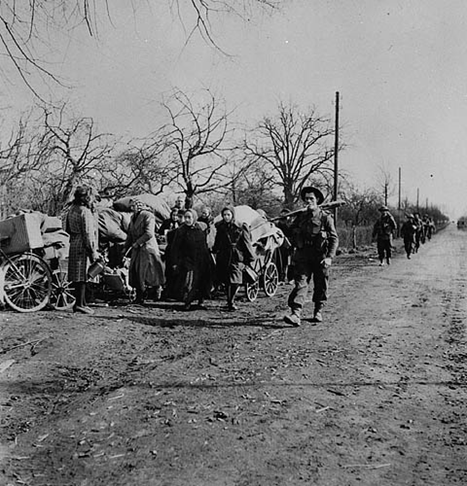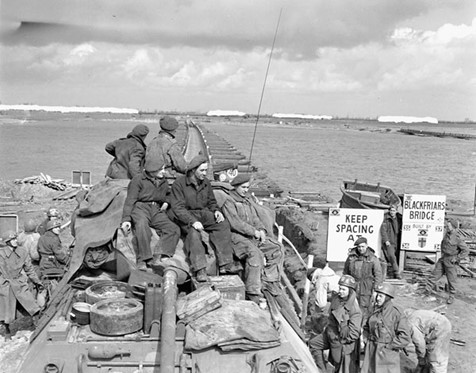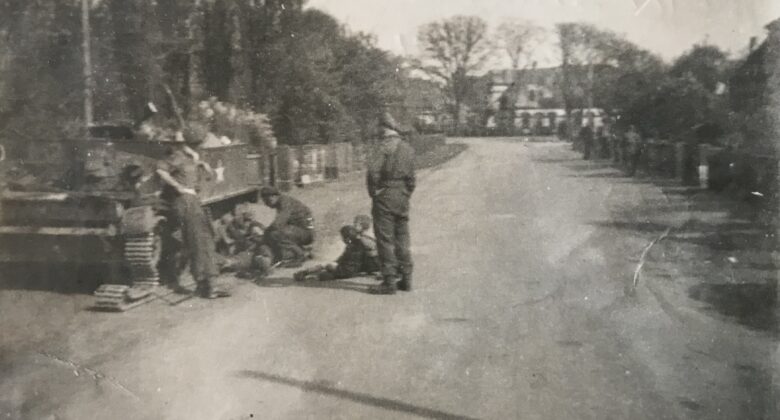
Following the battles of the Reichwald, by 1 March 1945, the War Diary of the 5th Battalion of the Duke of Cornwall’s Light Infantry (5 DCLI) were just inside Germany, ‘South of Kalkar, in the Canadian sector with role of left flank protection to the thrust through the Hochwald, the last defence line before the Rhine.’1 By late morning on 4 March 1945 B and D Companies had completed the capture of the village of Marienbaum just two miles from the Rhine river.
A typical patrol report gives a flavour of unit operations at the time. The significance of the moment is that the men of Cornwall were now occupiers rather than liberators:
1505 A [unreadable] patrol under Lt. L. Bacon. Stream at 093443 about 4 feet wide, bridge intact but will not take wheels. Windmill 093488 unoccupied except by civilians. Road bridge at 094437 cratered, not passable for wheels. White flags in houses 097439, no enemy movement seen. Xanten Church clearly visible from house 087443.2
Emphasising that 5 DCLI were now occupiers as opposed to liberators were messages from Brigade HQ reporting that signal lines are being cut. In addition to requesting that cases are reported and line parties informed, the Battalion was to, ‘Arrest and keep in custody any civilians out after dark.’3 On the 6 March 1945 at 1645 there was a warning order that, ‘all civilians will be evacuated from our area by 10 March.’4 The closing entry for 7 March 1945 elaborated on the removal of civilians from the area: ‘All civilians on Rhine side of Cleve – Xanten [unreadable] are being evacuated by 9 March. Organised evacuation and no action to be taken until orders received. Civilians will take only what they can carry. No evacuation of stock. Minimum herdsmen left to look after stock. Transport provided for sick and infirm. Warning order to civilians may be given.’5

On the 10 March 1945 the ‘Battalion now in a reserve position while the final clearing to the Rhine at Xanten and Wesel is done.’6 Then, reverting to their role as liberators, the Battalion moved out of Germany on 12 March 1945 to Heijen, near Gennep in Holland.
Between the 17-23 March various Brigade and Battalion conferences were held regarding the crossing of the Rhine, eventually resulting with the 5 DCLI being allocated a crossing point at ‘the river at Rees and Wesel towards Aalten.’7 The crossing of the Rhine, known as Operation Plunder, started at night on 23 March but little was recorded regarding 5 DCLI activity at this point as they were not assigned an assault role.
On 27 March 1945 at 0030 ‘The Battalion began to move out of the marshalling area, to cross the Rhine.’ 8We can only guess at the thoughts of those who participated in this endeavour. Perhaps it was just another river crossing? But surely there must have been a feeling from combatants that this was unique. The Rhine not only represented a physical barrier but a psychological barrier as well. The American Army had already crossed the Rhine further south at Remagen and Montgomery’s set piece crossing north of the Ruhr would deflate resistance further.

5 DCLI now concentrated at Esserden, North West of Rees, on 27 March 1945, ready for their next operation, the capture of Megchelen, Holland. The attack eventually materialised as a night assault on the 27-28 March and resulted in the capture of 94 Prisoners of War. At 2000 hours, a Brigade Liaison Officer informed the Battalion it would be relieved. The 30 March 1945 saw the Battalion move to a concentration area in woods South West of Anholt, ‘ready for the breakout from the Rhine bridgehead, which will take us across Holland and Germany and see the final battles of the war.’9 31 March 1945 started with reveille at 0600 and the Battalion was placed at one hours’ notice to move. At 1300 the Battalion moved off marking ‘the beginning of the breakout.’10 The 43rd (Wessex) Division, of which 5 DCLI were part, advanced with the long-distance objective of Lingen in Germany some 80 miles away. The Battalion would be entering the heart of Germany and only time would tell how hard the fighting would be and what they might find.

